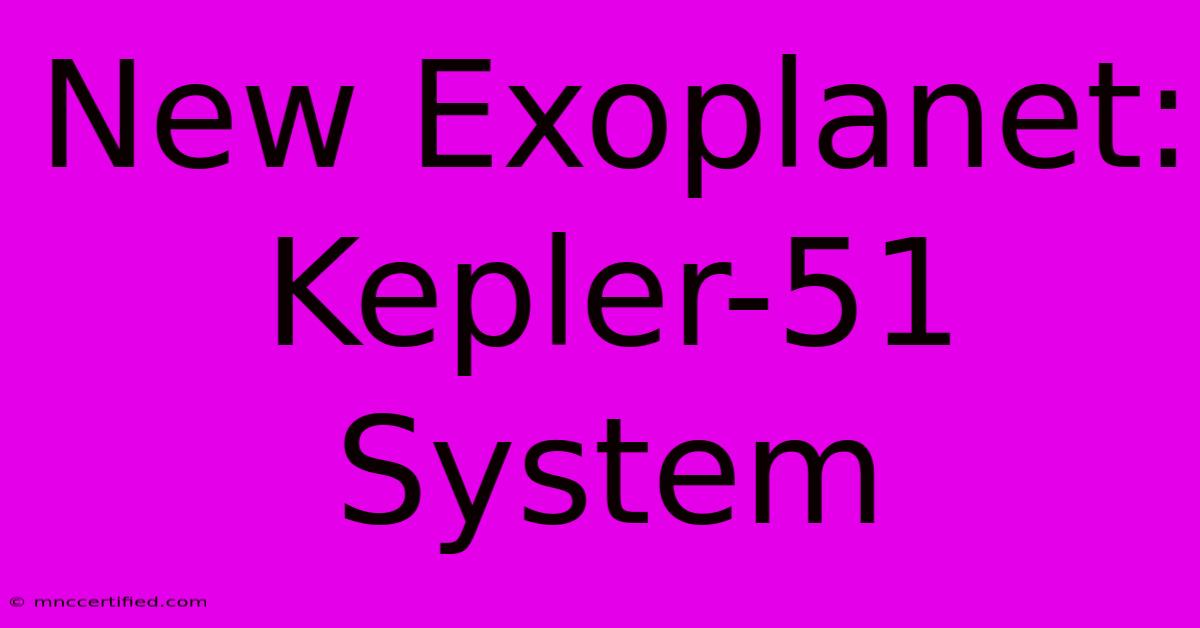New Exoplanet: Kepler-51 System

Table of Contents
New Exoplanet Discoveries in the Kepler-51 System: A Deep Dive
The Kepler-51 system, located approximately 2600 light-years from Earth in the constellation Cygnus, has captivated astronomers for years. Initially known for its trio of unusually puffy planets, Kepler-51b, Kepler-51c, and Kepler-51d, recent research and advanced observation techniques have added new layers of complexity and intrigue to our understanding of this fascinating planetary system. This article will explore the latest discoveries regarding the Kepler-51 system, focusing on the characteristics of its planets, the mysteries surrounding their low densities, and the implications for our understanding of planetary formation and evolution.
The Puffy Planets of Kepler-51: A Unique Anomaly
The Kepler-51 system's most striking feature is its three large, low-density planets. These "super-puffs" possess radii significantly larger than Neptune, yet their masses are surprisingly low, resulting in exceptionally low densities. This is unusual, as planets of this size are typically expected to have much higher densities. Kepler-51b, Kepler-51c, and Kepler-51d challenge existing planetary formation models, sparking extensive research into their atmospheric composition and evolutionary pathways.
Kepler-51b: The Innermost Super-Puff
Kepler-51b, the innermost planet, is the smallest of the three super-puffs. Its low density suggests a significant proportion of its mass is made up of a thick, extended atmosphere, potentially composed of hydrogen and helium. Further research is needed to precisely determine the atmospheric constituents and understand the dynamics that have led to its unique characteristics. Observational data from advanced telescopes like the James Webb Space Telescope (JWST) could provide critical insights into Kepler-51b's atmospheric composition.
Kepler-51c and Kepler-51d: Larger, Equally Enigmatic
Kepler-51c and Kepler-51d are larger and more distant from their host star than Kepler-51b. Their low densities are similarly puzzling, reinforcing the mystery surrounding the formation and evolution of the Kepler-51 system. Studying the differences between these three planets could reveal important clues about how these unusual atmospheric structures form and evolve over time. The orbital periods and distances of these planets also provide valuable data points for understanding planetary migration and gravitational interactions within the system.
Unraveling the Mystery: Formation and Evolution Hypotheses
Several theories attempt to explain the existence of these super-puff planets:
-
Early Formation and Slow Contraction: One hypothesis suggests these planets formed early in the system's history, accumulating a large amount of gas before their cores had fully condensed. This would result in a large, extended atmosphere that has not yet had sufficient time to contract.
-
Tidal Interactions and Orbital Migration: Another possibility involves gravitational interactions between the planets and the Kepler-51 star. Tidal forces could have inflated the planets' atmospheres, leading to their low densities. Orbital migration, a process where planets move closer or further from their star over time, also plays a significant role in shaping the system's architecture and could have impacted the planets' evolution.
Future Research and Observational Strategies
Further investigation into the Kepler-51 system is crucial for advancing our understanding of planetary formation. Future research will focus on:
-
Atmospheric Characterization: Using advanced telescopes like JWST to analyze the planets' atmospheres, determining their composition and structure.
-
Orbital Dynamics: Precisely measuring the planets' orbital parameters to understand their gravitational interactions and evolutionary history.
-
Comparative Planetology: Comparing the Kepler-51 system to other planetary systems with similarly low-density planets to identify commonalities and differences.
The Kepler-51 system serves as a unique laboratory for studying the formation and evolution of low-density planets. The ongoing research promises to revolutionize our understanding of planetary diversity and the processes that shape exoplanetary systems. With continued observation and sophisticated data analysis, the mysteries surrounding the Kepler-51 system's super-puffs are likely to be gradually unveiled, enriching our understanding of the cosmos.

Thank you for visiting our website wich cover about New Exoplanet: Kepler-51 System. We hope the information provided has been useful to you. Feel free to contact us if you have any questions or need further assistance. See you next time and dont miss to bookmark.
Featured Posts
-
Bella Hadid And Yellowstone Unnecessary Drama
Dec 10, 2024
-
Do Insurance Cover Towing
Dec 10, 2024
-
Aetna Whole Life Insurance
Dec 10, 2024
-
Crypto Vaccine For Calves
Dec 10, 2024
-
Postecoglou Tottenhams Next Manager
Dec 10, 2024